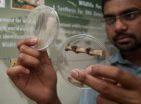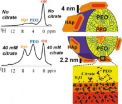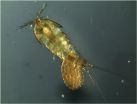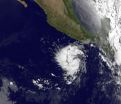(Press-News.org) Wildlife face many threats with spreading urbanization, including habitat loss and inbreeding when populations become fragmented and isolated. It doesn't help that there is a billion-dollar international industry dedicated to the illegal trafficking of wild animals or wild animal parts.
The Conservation Genetics Lab at the University of Arizona is working to conserve and protect wild animals around the world.
"Our work here deals with using genetics for wildlife conservation," said Ashwin Naidu, a doctoral candidate in the School of Natural Resources and the Environment.
One of the largest threats to wildlife is loss of genetic diversity through inbreeding, which can lead to lower levels of reproductive fitness or disease susceptibility and can endanger a population's survival.
As urbanization increases, more and more wildlife habitats are destroyed, leaving populations of wild species cut off from each other, marooned on isolated "islands" of natural land in a sea of human development. Small populations that become trapped in these fragmented habitats are unable to breed outside of their local gene pool – and the Conservation Genetics Lab steps in to help.
The researchers use genetic techniques to identify whether small populations of wild animals that have become isolated because of habitat fragmentation are inbred or in danger of becoming inbred.
"We want to know how individuals are related to each other across a landscape," said Naidu. "We have populations of species, and we want to see if there is genetic differentiation, indicating a barrier between the populations, or if there is gene flow across the populations."
The researchers extract DNA from animal samples such as hair, bones or carcasses, or blood samples and cheek swabs if the animal is captured.
"We amplify DNA to look for certain areas in the genome," said Naidu. "Every species has a unique DNA sequence known as a DNA barcode and every individual has a unique genetic fingerprint."
There are several specific locations on a genome where the order of genes or base-pair sequences varies between individuals, populations or species, said Naidu. "One is the nuclear DNA, DNA contained inside the cell's nucleus. Another is mitochondrial DNA, or DNA located inside the mitochondria of the cell."
"Once we amplify and generate multiple copies of these locations, all of this data is analyzed through DNA sequence analysis software," said Naidu. "If we want to look at variation within individuals we look at unique genome types, what we call DNA fingerprints. If we want to look at variation within species we look at the mitochondrial DNA sequences called barcodes."
DNA fingerprints and barcodes from individual samples then are compared with a genetic database of species and populations that previously have been studied.
If a population is found to have inbred, the Conservation Genetics Lab goes to the rescue.
"We take a few individuals from populations that show good genetic diversity and we introduce them, or trans-locate them, into the population that is suffering from inbreeding," said Naidu. "When we introduce new genetic variation into a small population that is undergoing inbreeding, we have the potential to bring them back to a higher genetic diversity."
"We observe and monitor these populations to see if they're doing well. Then we genetically test them again to find out the level of genetic diversity after the translocation. Has it balanced, is it good enough for their survival? If it's not, then we need more translocations."
The same technique is applied to endangered or critically endangered animals that require captive breeding. Animals that are bred in captivity for good genetic diversity can be reintroduced to the wild to genetically rescue the wild population.
Genetics also can be used to identify species in areas where they previously haven't been known to exist. "Sometimes we find samples of an animal, such as feces, carcasses, bones or hair, and this is evidence for presence of the animal. But how do you confirm what species of animal it is? Genetics is a very useful tool for identifying the species," said Naidu. "DNA evidence can be obtained from ancient sources as well, such as fossils or bones which are being excavated."
And wildlife forensic genetics has yet another application: catching criminals.
Forensic genetics can be used to identify the victims and criminals in wildlife crime cases in the same way that genetics is used to solve human crime cases. The Conservation Genetics Lab along with state and federal wildlife management agencies works to fight against cases of wildlife crime.
"Wildlife forensics particularly deals with investigating crime cases where you have a shipment of animals or animal parts that have been transported internationally and are seized by officials at the border, or later are identified as not being native to the country they are found in," said Naidu. "How would you know which country or which region these animal parts or animals came from? Wildlife forensic genetics is really kicking in because of all this new technology that's available for species identification and source population identification."
Forensic genetics can answer questions such as the species, origin and source population of the animal or animal part, as well as identify whether it was bred in captivity or caught in the wild. "All of these are general questions when you look at samples such as meat, hides, burnt skin or other morphologically unidentifiable samples where you need to extract DNA and identify them genetically," said Naidu.
The lab also deals with specific cases of wildlife crime.
"Let's say a hunter has a license to shoot one species, but he has shot another species and claims that this is what he had a hunting license for," said Naidu. "But a wildlife manager sees a little bit of blood or some hair or remains from the animal in the bed of the hunter's vehicle and wants to know exactly what species it is and which population it belonged to. So he collects some samples from the back of the truck and sends them to the lab and we identify species or individuals to determine whether it is really the species the hunter had a license for."
Once evidence is obtained showing that a hunter illegally has taken a species, the evidence may be presented in court. "These results are so scientifically robust that they are just like human DNA court cases," said Naidu. "There are a lot of cases in illegal or in wildlife crime that need good scientists to go and testify in courts and I think that's a very important move that needs to be made by scientists for the benefit of wildlife conservation in this world."
"My dream is to establish a lab and a forensic unit that will focus particularly on wildlife forensic genetics dealing with collection of field evidence, chain of custody and presentation of evidence to testify in court. This lab would operate on global standards and allow for communication between other such labs," said Naidu.
INFORMATION:
Naidu's research is funded by the U.S. Fish and Wildlife Service and the Arizona Game and Fish Department. He is also associated with the International Union for Conservation of Nature's Cat Specialist Group.
Saving wildlife with forensic genetics
Using forensic genetics techniques, the UA's Conservation Genetics Lab is working to protect wild animals and catch the criminals in cases of wildlife crime
2011-06-09
ELSE PRESS RELEASES FROM THIS DATE:
Researchers discover superatoms with magnetic shells
2011-06-09
RICHMOND, Va. (June 8, 2011) – A team of Virginia Commonwealth University scientists has discovered a new class of 'superatoms' – a stable cluster of atoms that can mimic different elements of the periodic table – with unusual magnetic characteristics.
The superatom contains magnetized magnesium atoms, an element traditionally considered as non-magnetic. The metallic character of magnesium along with infused magnetism may one day be used to create molecular electronic devices for the next generation of faster processors, larger memory storage and quantum computers.
In ...
Lifelong gap in health between rich and poor set by age 20
2011-06-09
"We can't buy our way out of ageing," says Nancy Ross, a McGill geography professor. "As we get older we start to have vision problems, maybe some hearing loss, maybe lose some mobility – ageing is a kind of a social equalizer."
Ross is the lead author of a new study about how socio-economic and educational status affects Canadians' health-related quality of life over the course of a lifetime.
"My research looks at how poverty and social disadvantage affect your health status. Our work was about using social circumstances as a lens to look at how people's quality ...
Citrate key in bone's nanostructure
2011-06-09
AMES, Iowa - Bone is one of nature's surprising "building materials." Pound-for-pound it's stronger than steel, tough yet resilient. Scientists at the U.S. Department of Energy's Ames Laboratory have identified the composition that gives bone its outstanding properties and the important role citrate plays, work that may help science better understand and treat or prevent bone diseases such as osteoporosis.
Using nuclear magnetic resonance (NMR) spectroscopy, Ames Laboratory scientist and Iowa State University chemistry professor Klaus Schmidt-Rohr and his colleagues ...
Will psych majors make the big bucks?
2011-06-09
A new crop of college graduates have just landed on the job market. Right now they're probably just hoping to get any job, if at all. However, for psychology majors, the salary outlook in both the short and long term is particularly poor, according to a new study which will be published in an upcoming issue of Perspectives on Psychological Science, a journal of the Association for Psychological Science.
It's generally known that psychology majors don't make a ton of money when they're starting out; they're not like engineering students, many of whom go straight into a ...
How cells' sensing hairs are made
2011-06-09
Body cells detect signals that control their behavior through tiny hairs on the cell surface called cilia. Serious diseases and disorders can result when these cilia do not work properly. New research from UC Davis published this week in the journal Nature Cell Biology provides new insights into how these cilia are assembled.
"It's a basic discovery, but with implications for understanding disease," said Jonathan Scholey, professor of molecular and cellular biology at UC Davis and senior author of the study. Understanding how cilia are assembled and function can help ...
'Thermal pollution' in rivers not fully mediated by gravel augmentation
2011-06-09
Although adding gravel to a river to replace lost sediments won't likely cool the whole river channel, it can create cool water refuges that protect fish from thermal pollution, according to a U.S. Forest Service Pacific Northwest Research Station study.
The research—featured in the June 2011 issue of Science Findings, a monthly publication of the station—is among the first to explore the interplay between sub-surface water flow and temperature in large rivers and is helping to guide river restoration strategies in the Pacific Northwest.
In the study, which began ...
Eating a high-fat diet may rapidly injure brain cells that control body weight
2011-06-09
Obesity among people who eat a high-fat diet may involve injury to neurons, or nerve cells, in a key part of the brain that controls body weight, according to the authors of a new animal study. The results will be presented Tuesday at The Endocrine Society's 93rd Annual Meeting in Boston.
"The possibility that brain injury may be a consequence of the overconsumption of a typical American diet offers a new explanation for why sustained weight loss is so difficult for most obese individuals to achieve," said presenting author Joshua Thaler, MD, PhD, a faculty member with ...
Can evolution outpace climate change?
2011-06-09
Animals and plants may not be able to evolve their way out of the threat posed by climate change, according to a UC Davis study of a tiny seashore animal. The work was published today (June 8) in the journal Proceedings of the Royal Society B.
The tide pool copepod Tigriopus californicus is found from Alaska to Baja California — but in a unique lab study, the animals showed little ability to evolve heat tolerance.
"This is a question a lot of scientists have been talking about," said study co-author Eric Sanford, an associate professor of evolution and ecology at UC ...
UAB first in US with cell-processing workstation
2011-06-09
BIRMINGHAM, Ala. – The University of Alabama at Birmingham has taken a significant step toward making sophisticated cell therapy a part of patient care with its acquisition of the first cell-processing workstation (CPWS) from SANYO North America Corporation (SANYO) in the United States.
Richard Marchase, Ph.D., vice president for Research and Economic Development at UAB, says "UAB has a rich history of breaking ground in the cell-therapy arena. We are thrilled that we were able to be the first in the United States to use SANYO's CPWS. This will add to our world-class ...
A double-satellite NASA-style view of the first tropical storm in eastern Pacific: Adrian
2011-06-09
The first tropical depression in the Eastern Pacific Ocean is now the first tropical storm, and two satellites are providing NASA insights into its thunderstorms, rainfall, and intensity. NASA satellite data on newly born Tropical Storm Adrian shows high cloud tops and moderate rainfall, indications that the storm is getting stronger, triggering a tropical storm watch in Mexico.
Tropical Depression 1E is the first tropical depression of 2011 and formed in the eastern Pacific Ocean early on June 7. By the morning of June 8 it had strengthened into Tropical Storm Adrian, ...
LAST 30 PRESS RELEASES:
Sleeping in on weekends may help boost teens’ mental health
Study: Teens use cellphones for an hour a day at school
After more than two years of war, Palestinian children are hungry, denied education and “like the living dead”
The untold story of life with Prader-Willi syndrome - according to the siblings who live it
How the parasite that ‘gave up sex’ found more hosts – and why its victory won’t last
When is it time to jump? The boiling frog problem of AI use in physics education
Twitter data reveals partisan divide in understanding why pollen season's getting worse
AI is quick but risky for updating old software
Revolutionizing biosecurity: new multi-omics framework to transform invasive species management
From ancient herb to modern medicine: new review unveils the multi-targeted healing potential of Borago officinalis
Building a global scientific community: Biological Diversity Journal announces dual recruitment of Editorial Board and Youth Editorial Board members
Microbes that break down antibiotics help protect ecosystems under drug pollution
Smart biochar that remembers pollutants offers a new way to clean water and recycle biomass
Rice genes matter more than domestication in shaping plant microbiomes
Ticking time bomb: Some farmers report as many as 70 tick encounters over a 6-month period
Turning garden and crop waste into plastics
Scientists discover ‘platypus galaxies’ in the early universe
Seeing thyroid cancer in a new light: when AI meets label-free imaging in the operating room
Neutrophil-to-lymphocyte ratio may aid risk stratification in depressive disorder
2026 Seismological Society of America Annual Meeting
AI-powered ECG analysis offers promising path for early detection of chronic obstructive pulmonary disease, says Mount Sinai researchers
GIMM uncovers flaws in lab-grown heart cells and paves the way for improved treatments
Cracking the evolutionary code of sleep
Medications could help the aging brain cope with surgery, memory impairment
Back pain linked to worse sleep years later in men over 65, according to study
CDC urges ‘shared decision-making’ on some childhood vaccines; many unclear about what that means
New research finds that an ‘equal treatment’ approach to economic opportunity advertising can backfire
Researchers create shape-shifting, self-navigating microparticles
Science army mobilizes to map US soil microbiome
Researchers develop new tools to turn grain crops into biosensors
[Press-News.org] Saving wildlife with forensic geneticsUsing forensic genetics techniques, the UA's Conservation Genetics Lab is working to protect wild animals and catch the criminals in cases of wildlife crime



